February 12th, 2016 — 3:10am
If you are flying Thai Airways this month, take a look at my article in Sawasdee magazine about Ang Thong province, just north of Bangkok. I also have the cover shot.
The image was taken at Wat Muang, home to Phra Buddha Maha Nawamin, the largest Buddha statue in the country and the ninth tallest in the world. This spectacular 92-metre high (300 feet) and 63-metre (210 feet) wide seated Buddha towers over worshippers as they reach up to grasp its huge fingernails and whisper their prayers. Construction of this monumental golden image began in 1990 and was finally completed in 2008. Today, the faithful make merit here in the belief that they will be more successful in business.
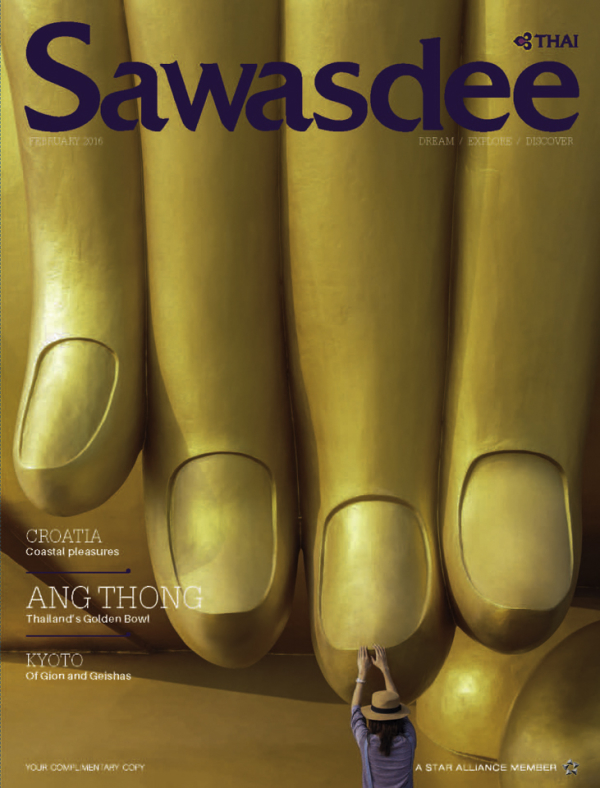
Comment » | places, Travel, uncategorised
June 24th, 2014 — 6:28am

On a recent visit to Ayutthaya I called in at the intriguing Wat Niwet Thammaprawat.

Built during the reign of Thailand’s King Chulalongkorn Rama V (1853 – 1910), Wat Niwet Thammaprawat is one of the country’s most surprising temples. From the outside, the building looks like a Gothic Christian church and there are few clues revealing that it is actually a Thai Buddhist temple.

Inside, the ornate décor continues the Christian style but with Buddhist imagery. The colourful stained glass windows include an image of King Chulalongkorn in royal attire.

For visitors who enter the beautiful temple it is a strange experience that plays with preconceived notions of religious imagery and its context.

The way of reaching the temple is equally unique. It is located on an island in the Chao Phraya River which is spanned by a small trolley-like cable car. Ring a bell and monks will bring you across. A visit to Wat Niwet Thammaprawat can also be tied in with a trip to Bang Pa-In Palace which lies on the opposite bank.

Comment » | places, Travel
June 5th, 2014 — 5:59am
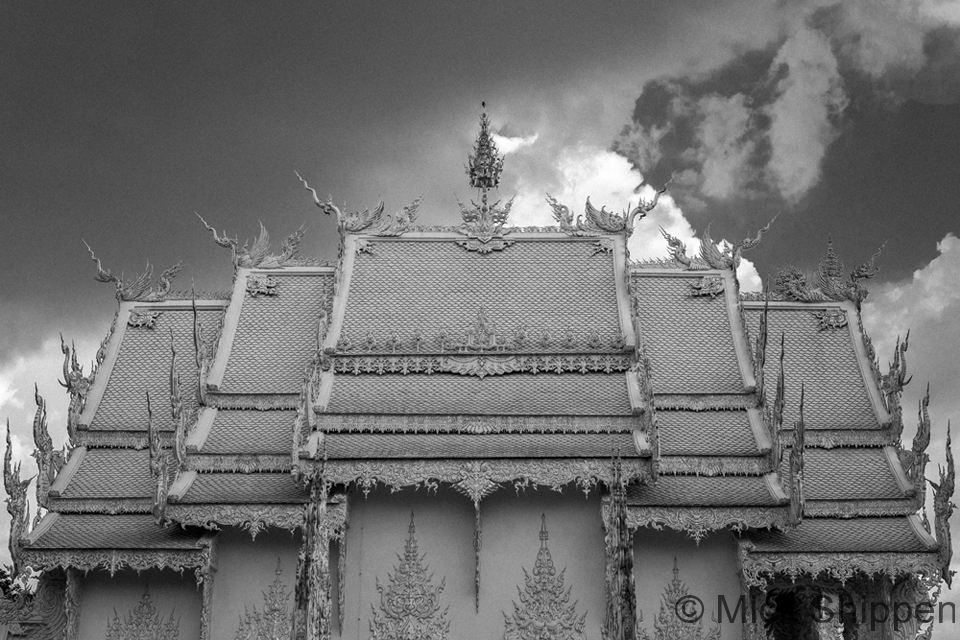
Last week I was in Chiang Rai updating a few images, enjoying eating and photographing the local food, and seeing how badly the city was affected by the recent earthquake.

Known as the Gateway to the Golden Triangle, the city of Chiang Rai lies in a fertile valley 180 km north of Chiang Mai. The town has a less commercial feel than Chiang Mai and consequently a more relaxed atmosphere. The town is also an excellent base for treks into the surrounding hills, trips to the border town of Mae Sai, and up to the tea plantations at Doi Mae Salong.
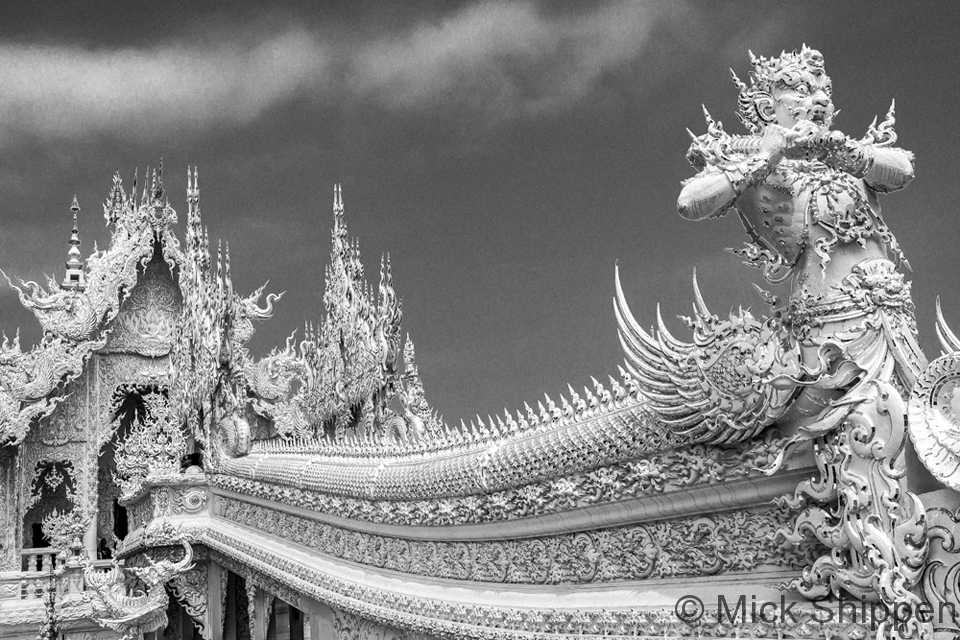
One of the most popular attractions near Chiang Rai is the spectacular Wat Rong Khun, more commonly referred to as The White Temple. I visited on a typically overcast rainy season day which seem well suited to black and white and a grainy finish.
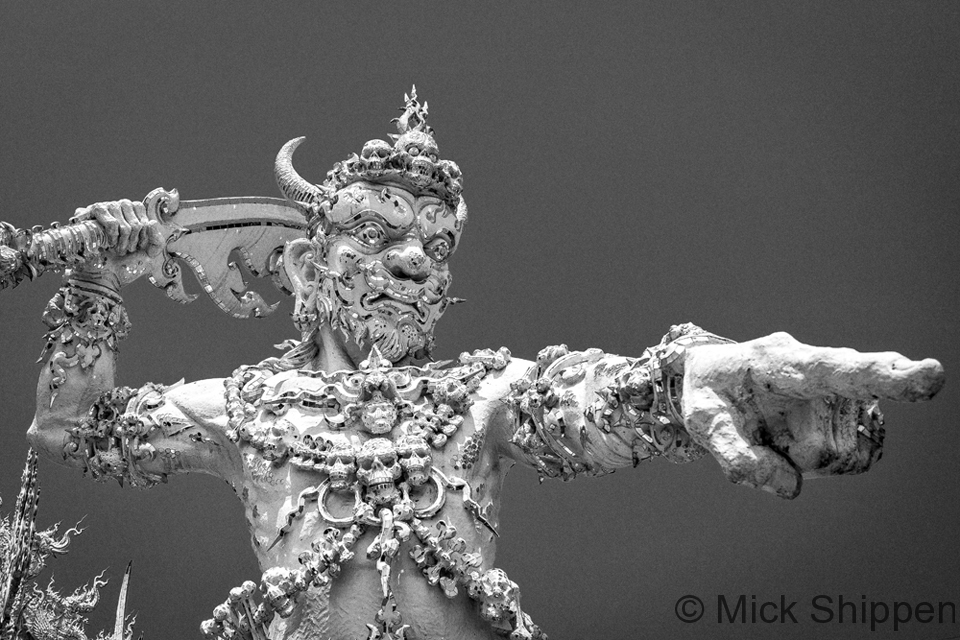
This beautiful temple is the on-going work of the renowned Thai artist, Chalermchai Kositpipat, and skilfully blends traditional Buddhist art with modern concepts. Unfortunately it was damaged in the recent earthquake but repair work is already underway.
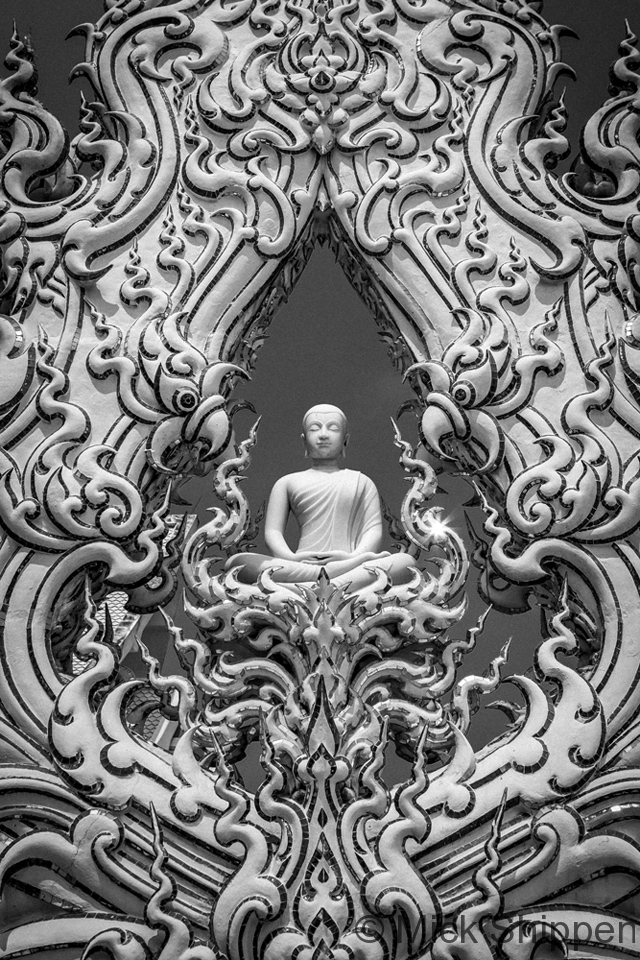
The unique building is entirely white and decorated with thousands of pieces of mirrored glass. Inside it contains murals, paintings and Buddha images. Wat Rong Khun is particularly impressive when visited on the night of a full moon.
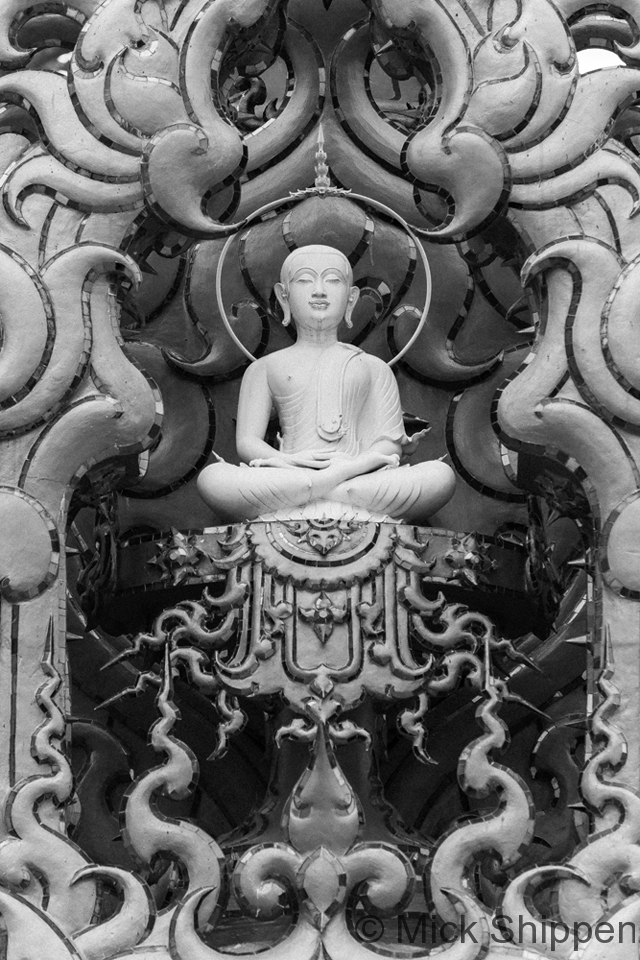
Despite the damage, the temple is still open to the public, although you cannot actually go inside at the moment.
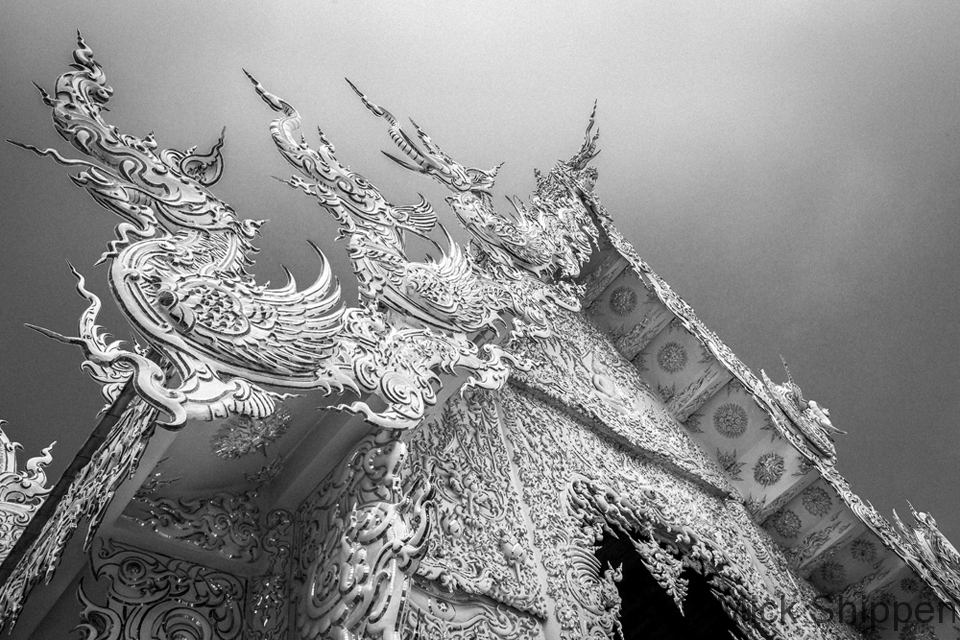
Wat Rong Khun is located about 15 km outside the city of Chiang Rai.
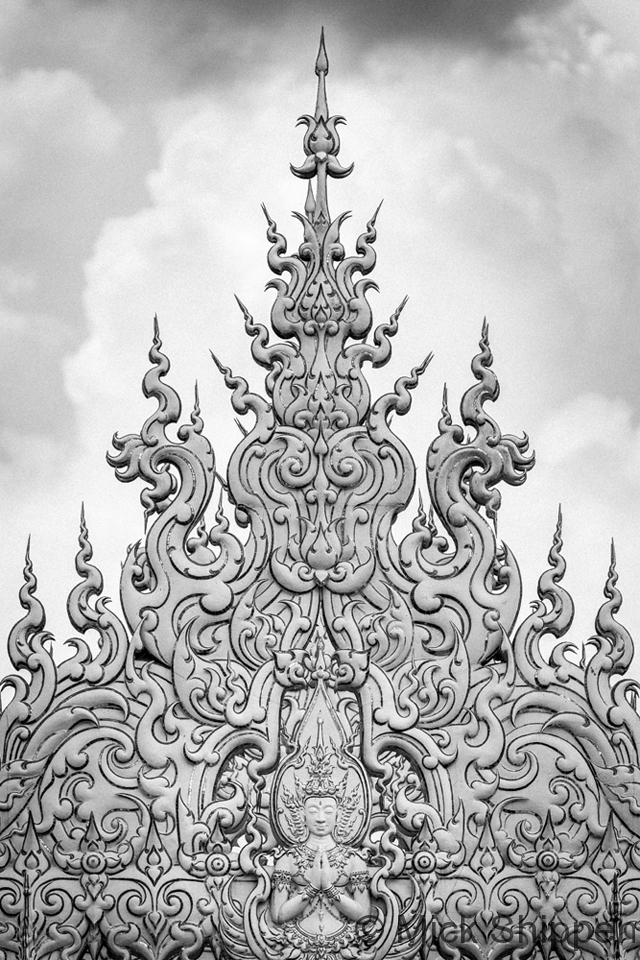
There couldn’t be a better time to visit the temple. It is free to enter but donations for the repairs will be welcome.

While in Chiang Rai I also visited another famous temple, Wat Phra Singh. More on that later in the week.

Comment » | places, Travel
May 27th, 2012 — 11:40am
Despite being based in Bangkok, I rarely find time to photograph the city. That has got to change as I recently signed a contract to do a book on the magical metropolis, know to locals as Krung Thep. With the deadline clearly visible on the not too distant horizon, I forced myself away from the desk and spent an enjoyable morning in Chinatown and relaxed evening in a bar opposite Wat Arun. I can’t tell you how good it is to have a job that allows me to enjoy a beer and eat while working.
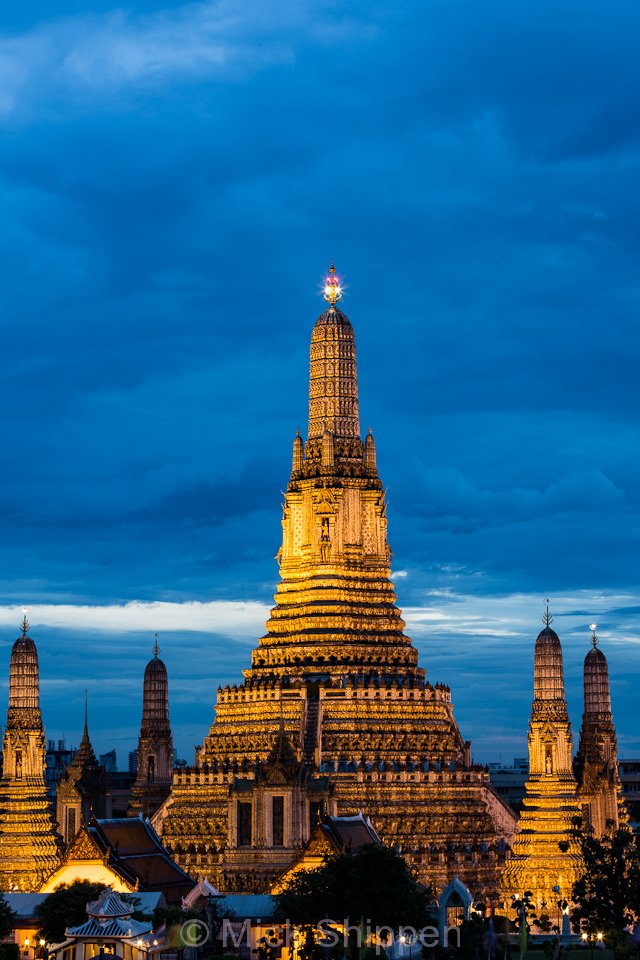
Wat Arun is one of the most photographed landmarks in Bangkok. The name means Temple of the Dawn, and the structure is comprised of one elongated prang or Khmer-style chedi surrounded by four smaller ones. The main tower is 82 metres high and features ornate decoration with mosaics made of porcelain and broken bone china. Unlike many of Bangkok’s other temples, this one looks better from a distance, especially when viewed from across the river. Despite its name, the best photographs of it are taken at sunset. Wat Arun is open every day from 8:30 a.m. – 5:30 p.m. Get off at Tha Tien Pier and take a ferry across the river.
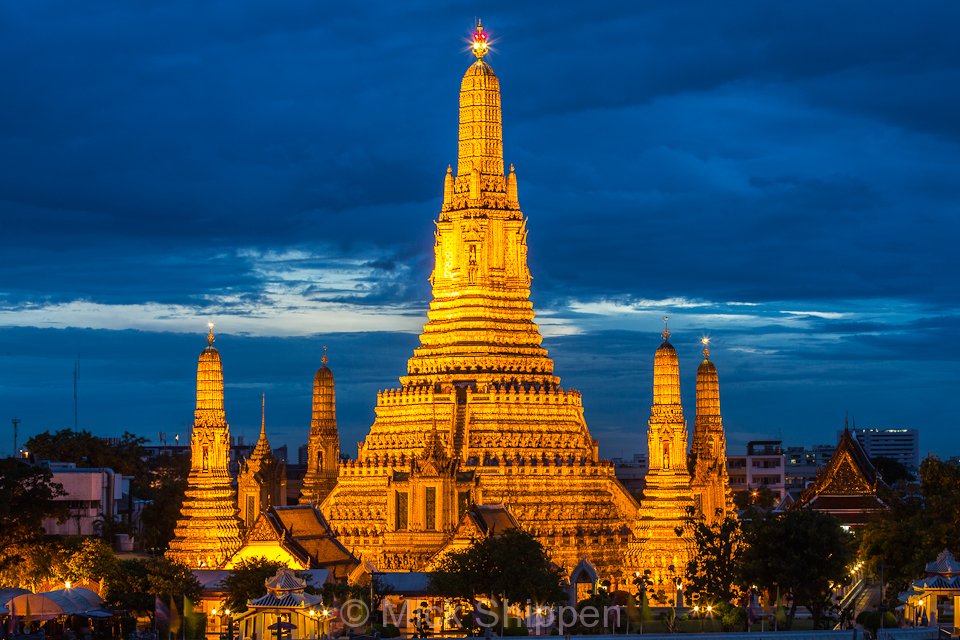
Comment » | Travel
February 22nd, 2011 — 5:04pm
I’ve been trying to take photographs at Wat Phra Kaew for a while but every time I go it is swarming with coach-loads of tourists. On two occasions I have simply turned back and promised to return when it is less busy; something that it never seems to be.
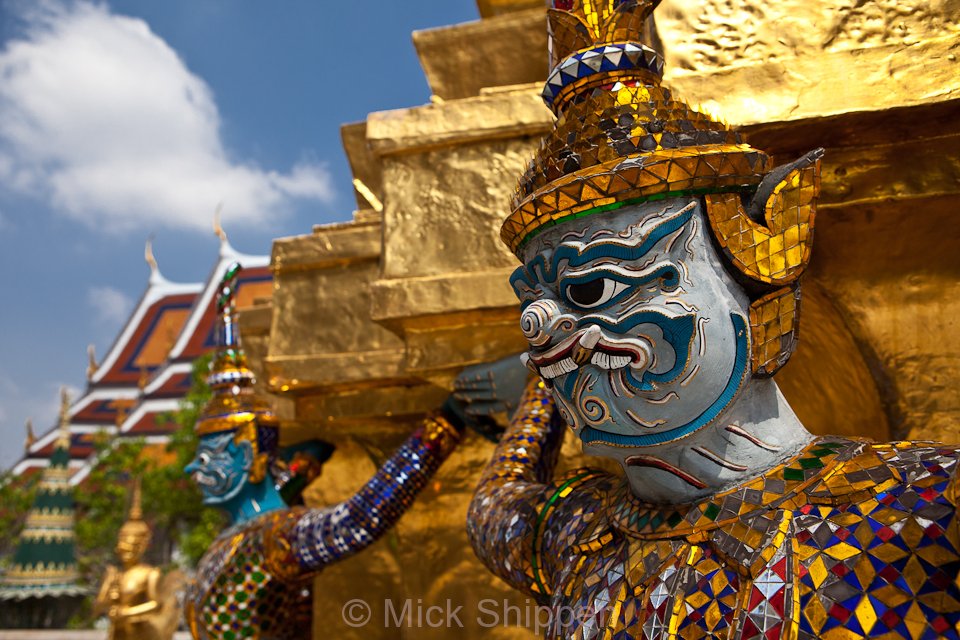
I even tried to seek assistance from the TAT, the terribly unhelpful Tourist Authority of Thailand, to see if I could be allowed in before or after opening hours. Although the TAT is extremely good at wasting money on large glitzy PR events and mega FAM trips for foreign media, it seems that when it comes to something useful, the answer is usually a resounding ‘no’ – assuming you are lucky enough to even get a response to your email enquiry. So, armed with a camera and a high degree of intolerance to mass tourism, I endeavoured to make Wat Phra Kaew appear a serene place that is seldom visited.
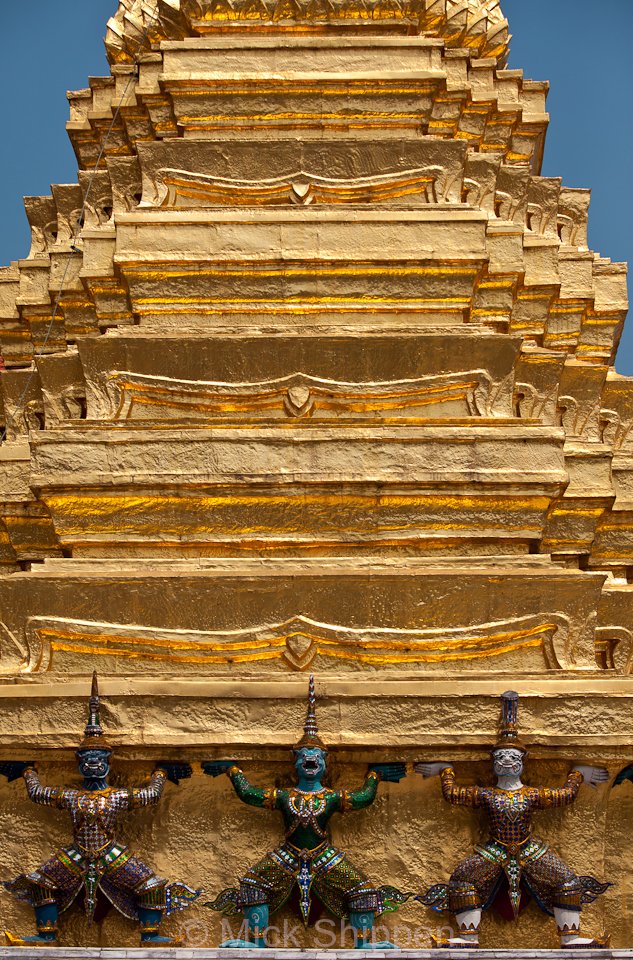
Of course, there is a good reason why it is on every itinerary. It is a simply stunning temple…just don’t expect to have a relaxed and contemplative experience. Being shoulder-barged out of the way by a Korean tourist desperate to be photographed imitating one of the sculptures is more likely…
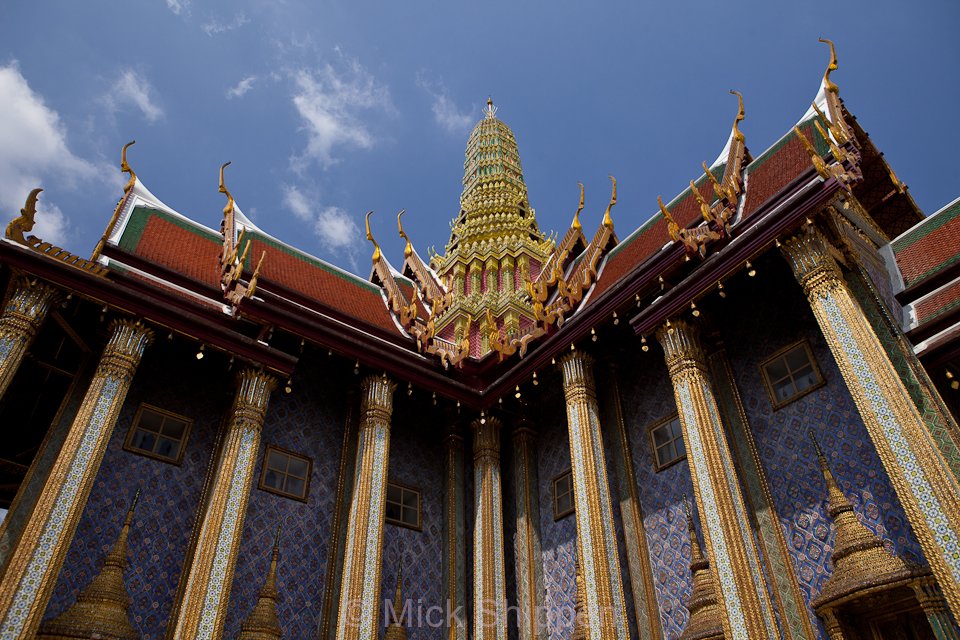
Wat Phra Kaew or the Temple of the Emerald Buddha and the nearby Grand Palace are highlights of any visit to Bangkok. The compound has over 100 buildings, golden spires and glittering mosaics.
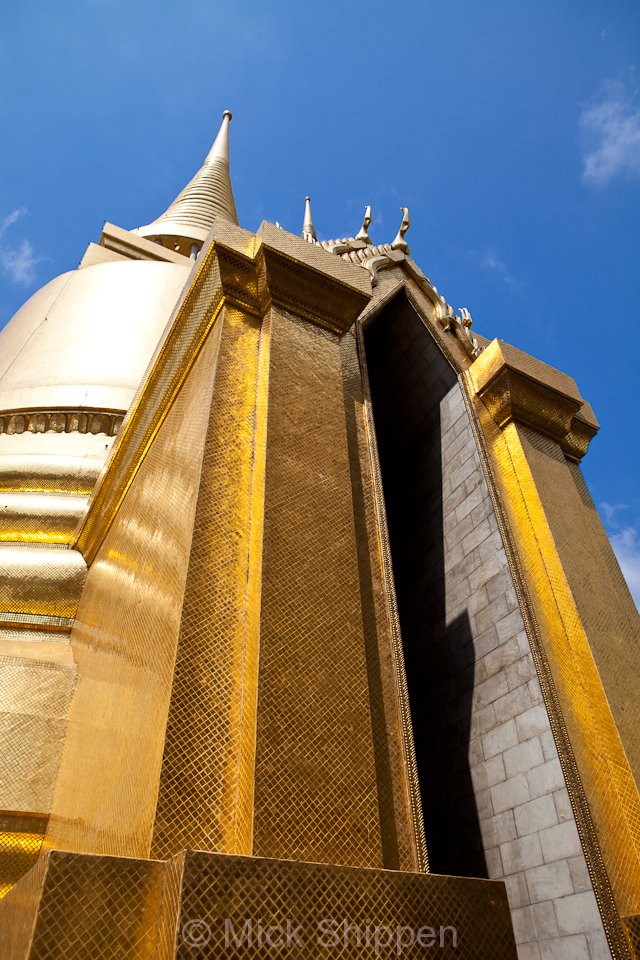
The temple dates back to the founding of Bangkok in 1782, and was built early in the reign of King Rama 1. It is Thailand’s most sacred temple and houses a 70 centimetre Emerald Buddha. The golden robe draped around the Buddha image is changed three times each year by King Bhumibol.
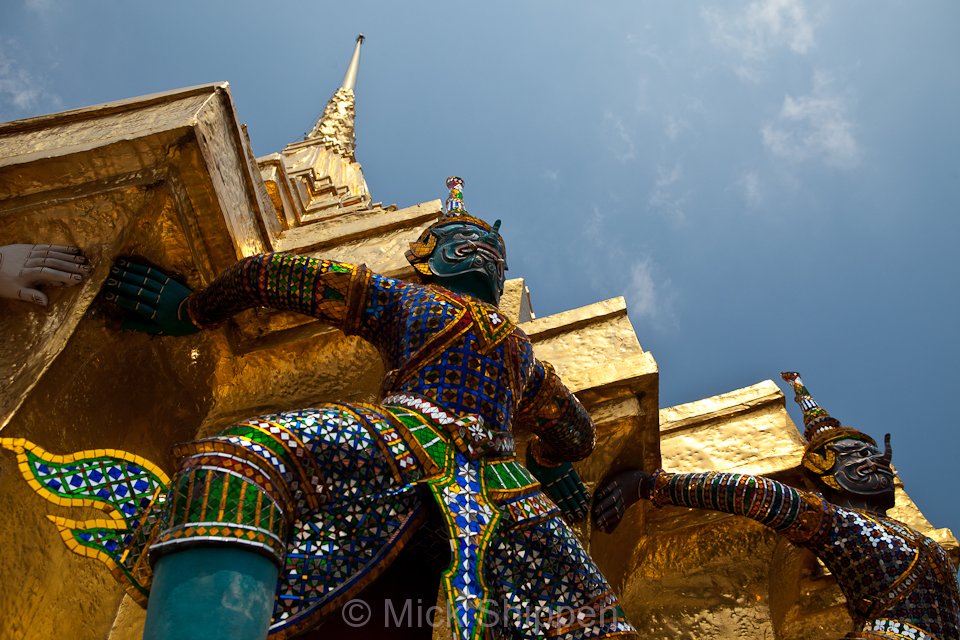
Today, Wat Phra Kaew still serves as a centre for all religious rites pertaining to the State and monarchy.
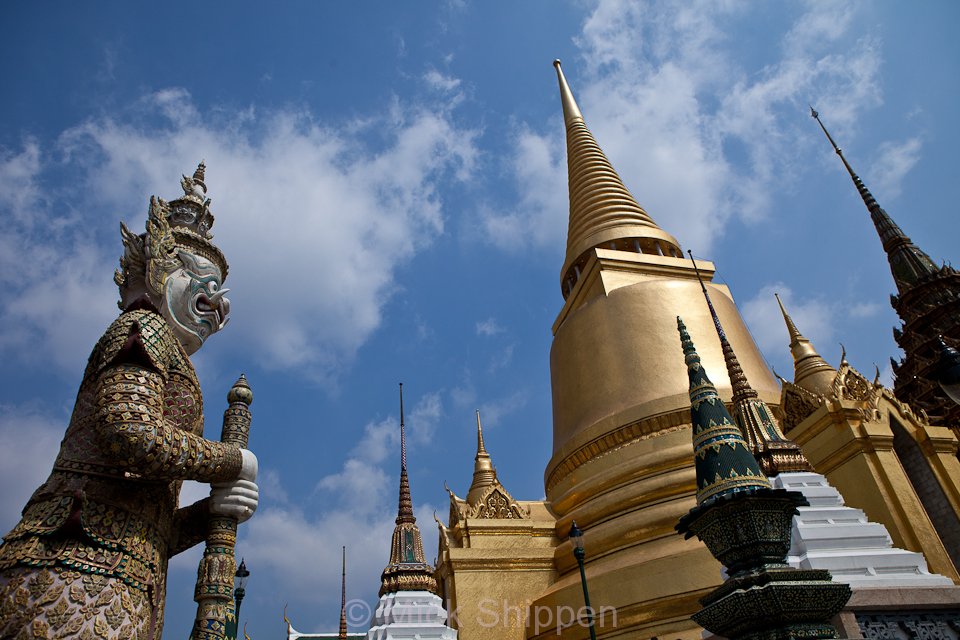
The easiest way to get to Wat Phra Kaew is to go by boat from the pier at Saphan Thaksin. Alight at Tha Chang pier and walk the short distance to the temple. Entry is 350 baht. Thais are free of charge.
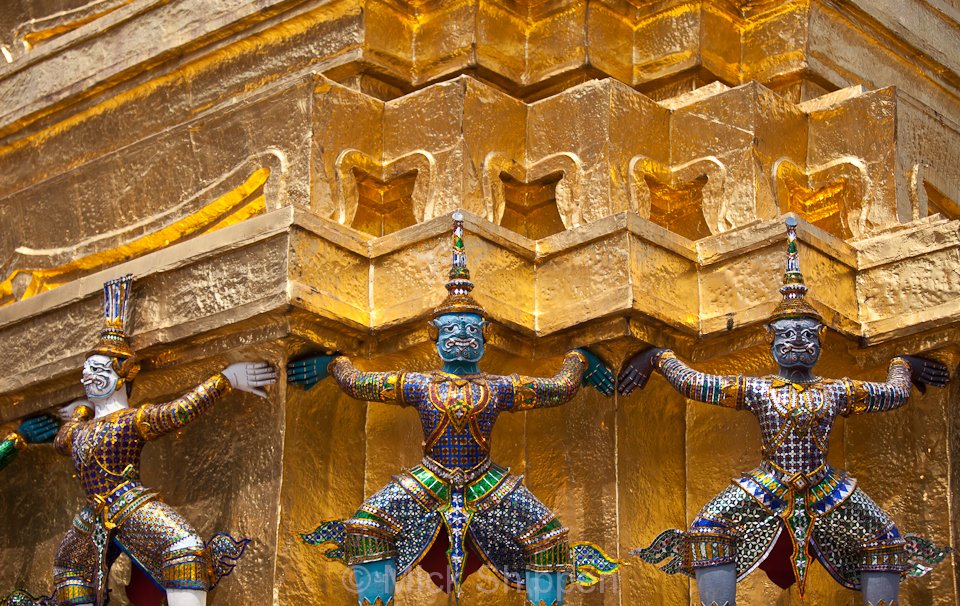
Comment » | Travel
February 14th, 2011 — 9:42pm
This month’s travel schedule has meant that I am late posting images taken during celebrations to mark the Year of the Rabbit. The day after it all took place, I headed off to Laos for a whirlwind tour of the south, taking pics for a forthcoming book.
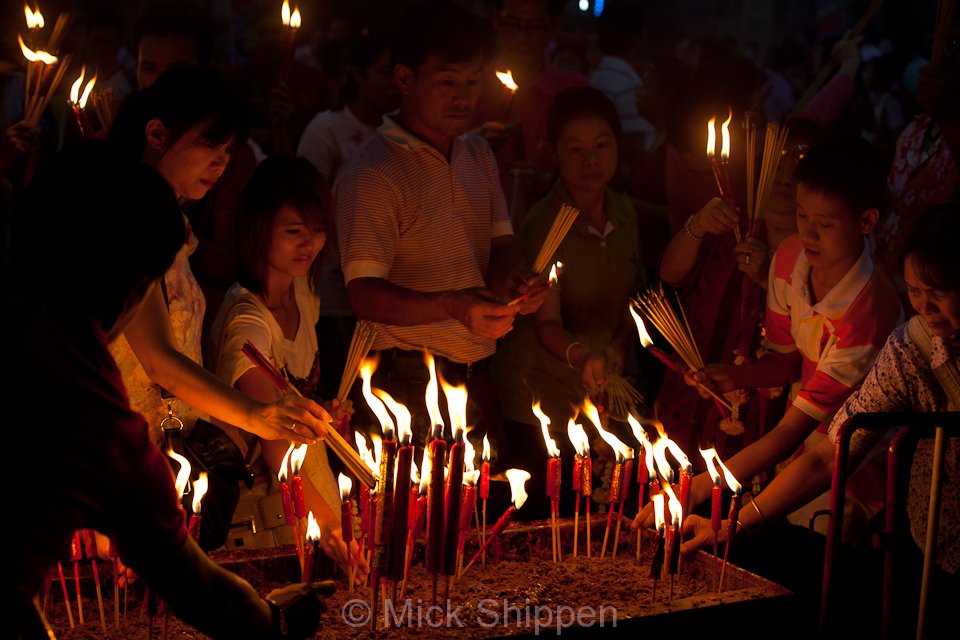
Having just returned, I’ve hastily sorted through a few shots taken at night in one of Bangkok’s many Chinatown temples.
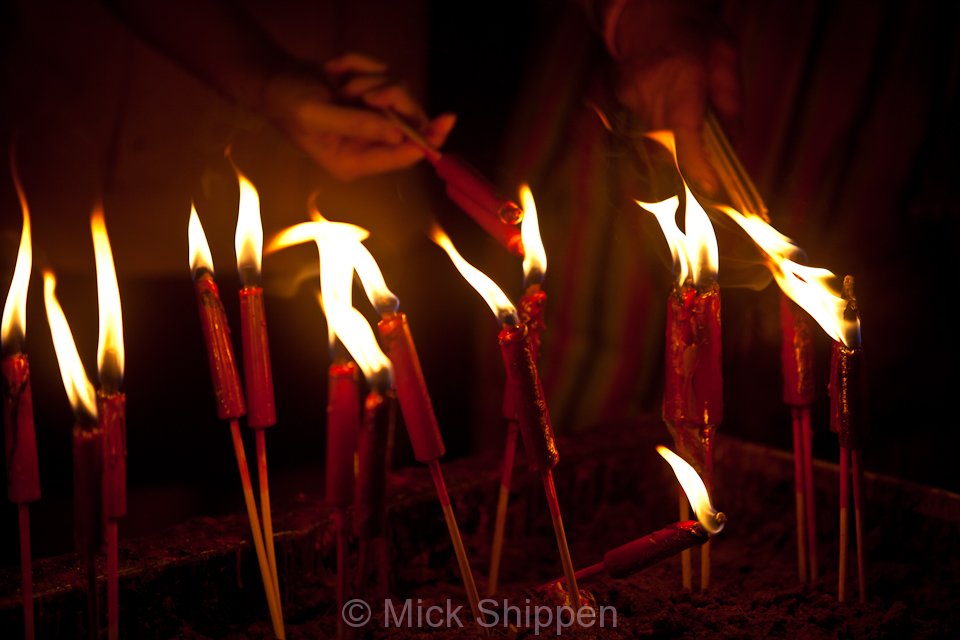
To be honest, the celebrations in the daytime, and mingling with the masses waiting to politicians to make an appearance didn’t do a lot for me so I decided to return in the evening when the whole event is far more atmospheric.
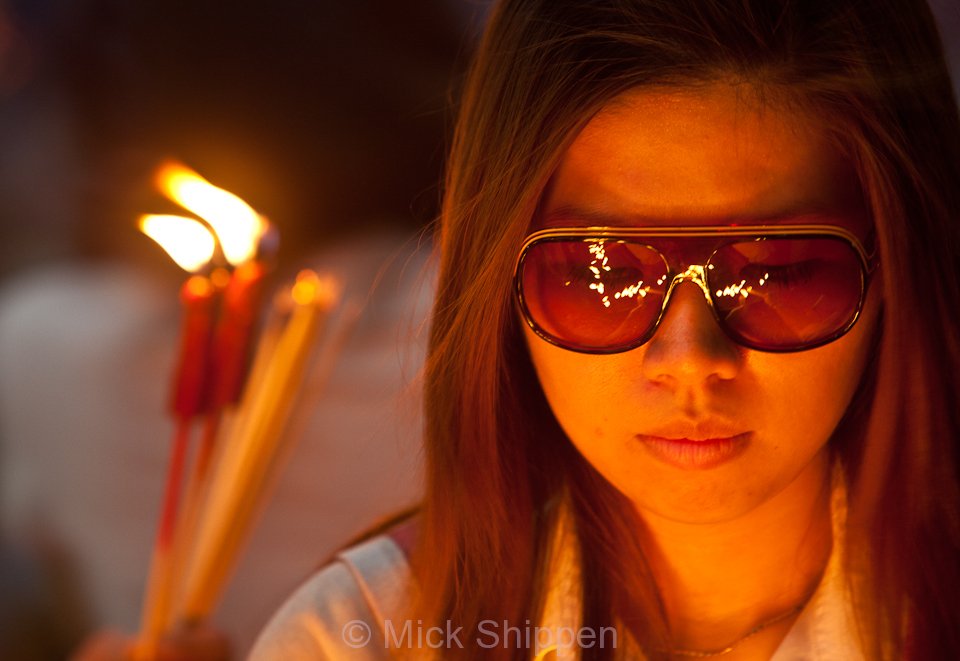
Thousands Thai- Chinese visit temples in the area throughout the day and night to make merit, light candles and incense, and receive blessings from monks.
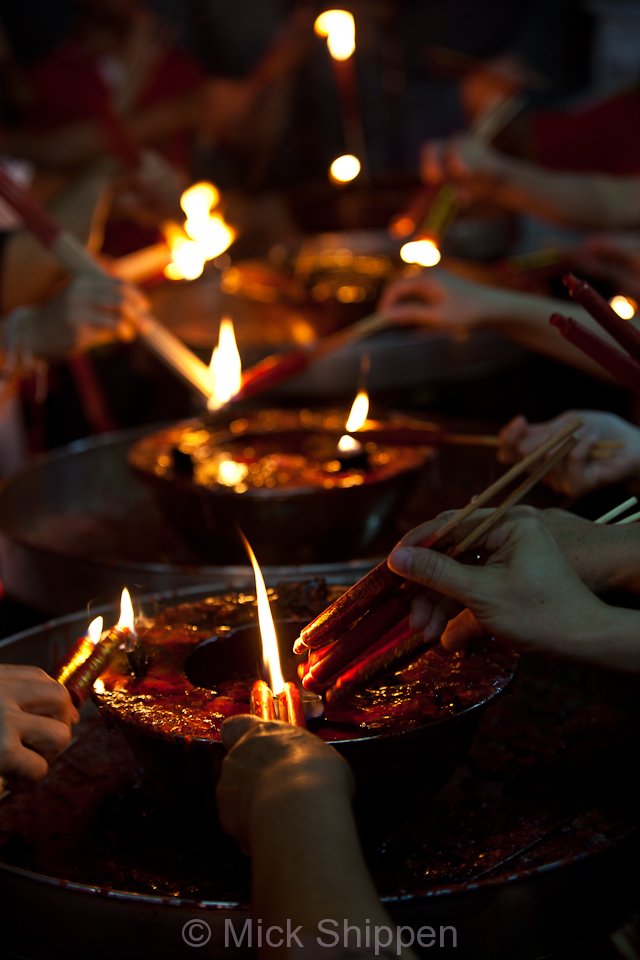
Chinatown is one of Bangkok’s most historic areas and was originally settled by Chinese traders during the Sukhothai era. According to local superstition, the long winding Yaowarat Road resembles a dragon’s body and is therefore an auspicious place to conduct business.
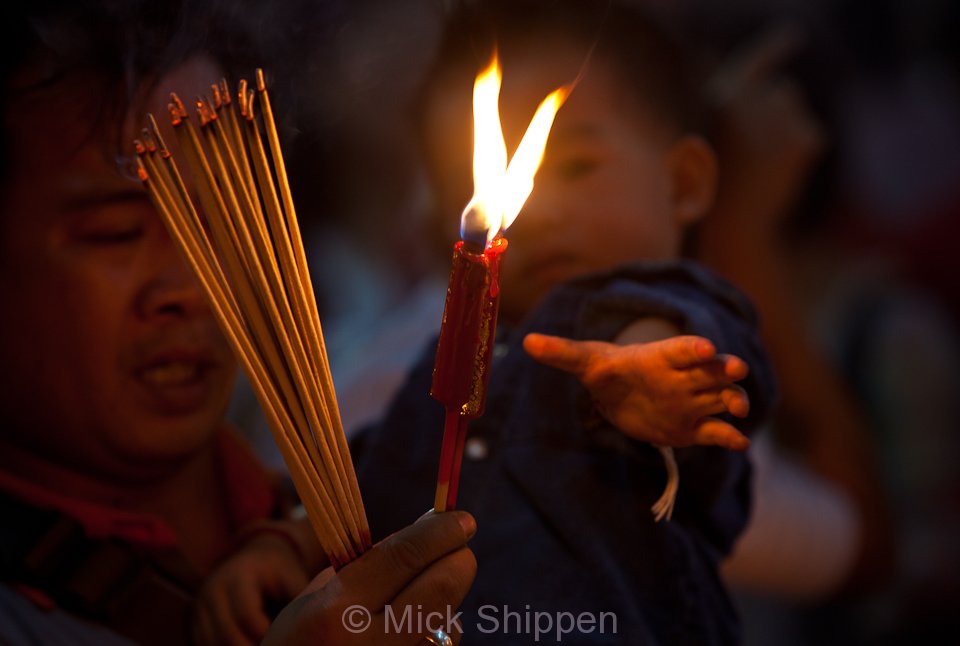
The most convenient way to get Chinatown is to travel on the MRT underground to Hualampong Station and then get a tuk-tuk or taxi.
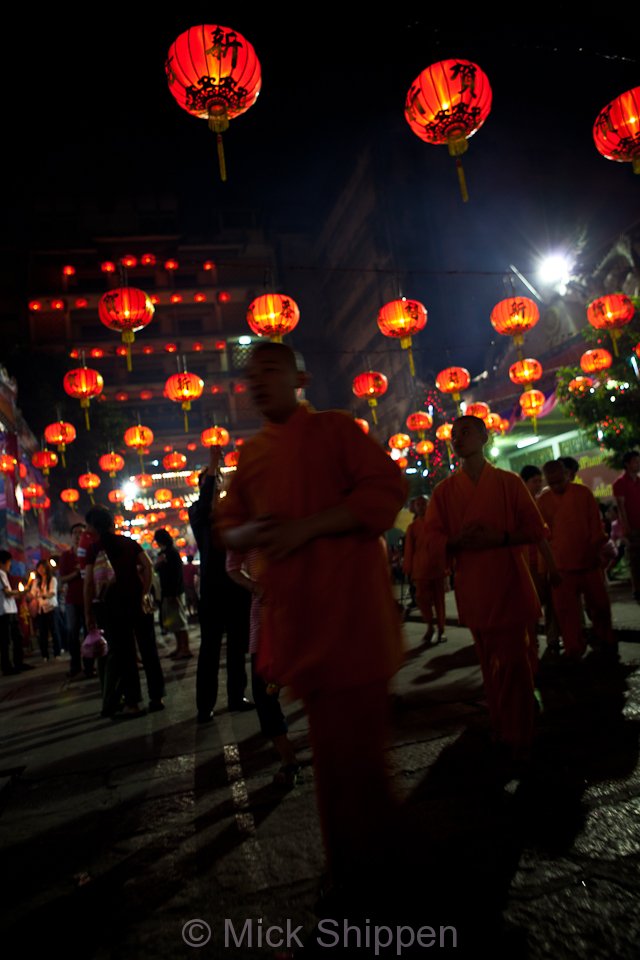
Comment » | Travel
January 28th, 2011 — 5:28pm
As a destination for a weekend or extended break from Bangkok, Chiang Mai is hard to beat. Despite the fact that the city has experienced far too much uncontrolled development in years and suffers from bad pollution, I still have a deep affection for Chiang Mai. In fact I lived there for about six years, so know it extremely well.
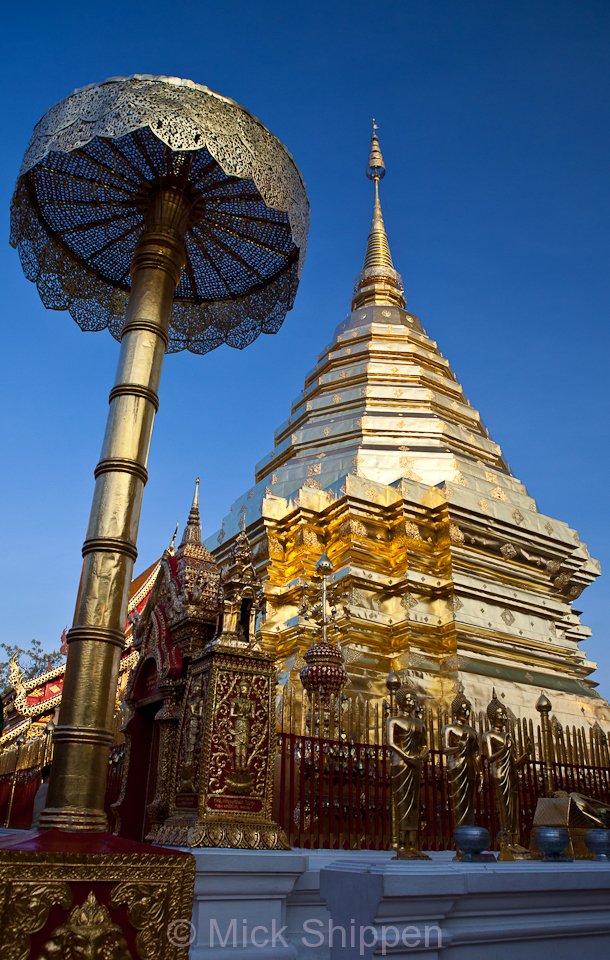
With a dirt bike at my disposal for the weekend I took a blast up to Doi Suthep, a 1600 metre peak that overlooks Chiang Mai. It is also home to the famous temple, Wat Pra That Doi Suthep. The 15 kilometre journey is a winding rollercoaster ride, superb on a motorcycle.
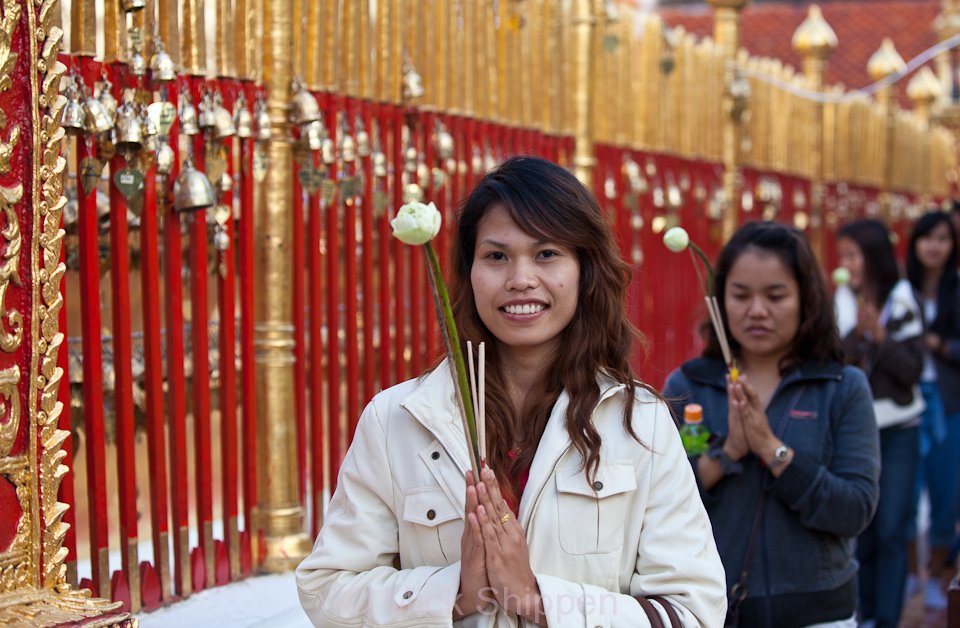
The temple is incredibly popular with Thai visitors to the city who go to pay respect at what is generally regarded as one of the country’s most sacred religious sites. Once you reach the car park and market at the site, there’re 306 steps to tackle in order get to the actually temple. It’s definitely worth the climb but try to go as early as possible to avoid the crowds.
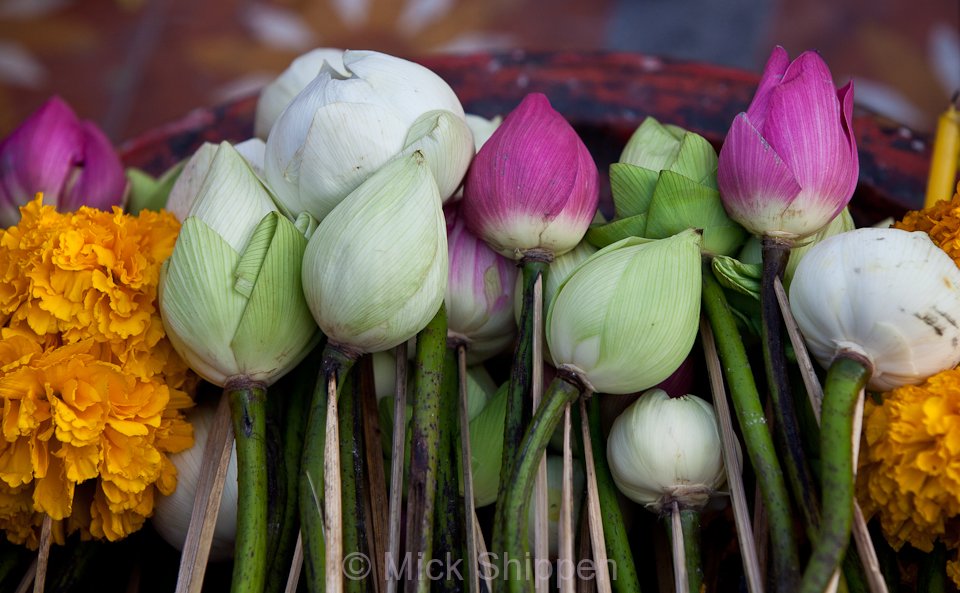
At the temple, it is tradition to walk around the golden chedi three times before lighting incense and a candle, and offering a lotus flower to an image of Buddha.
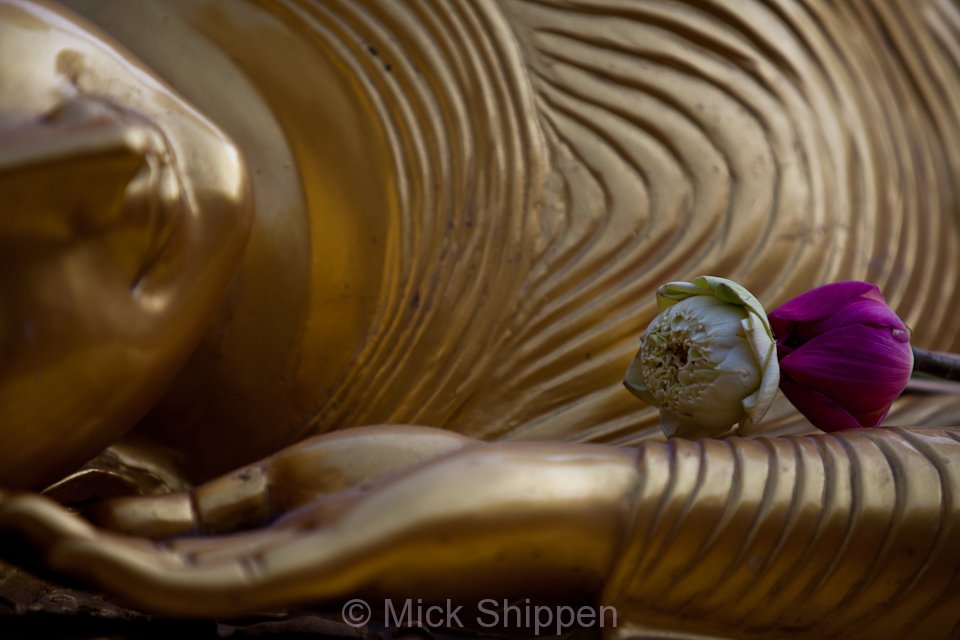
There are plenty of nice details to pick up on through the lens.
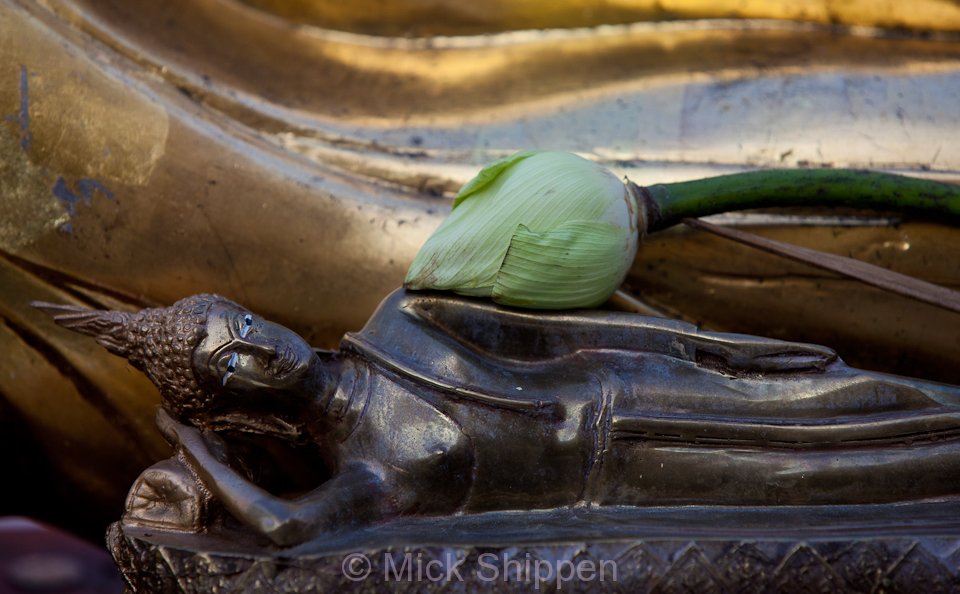
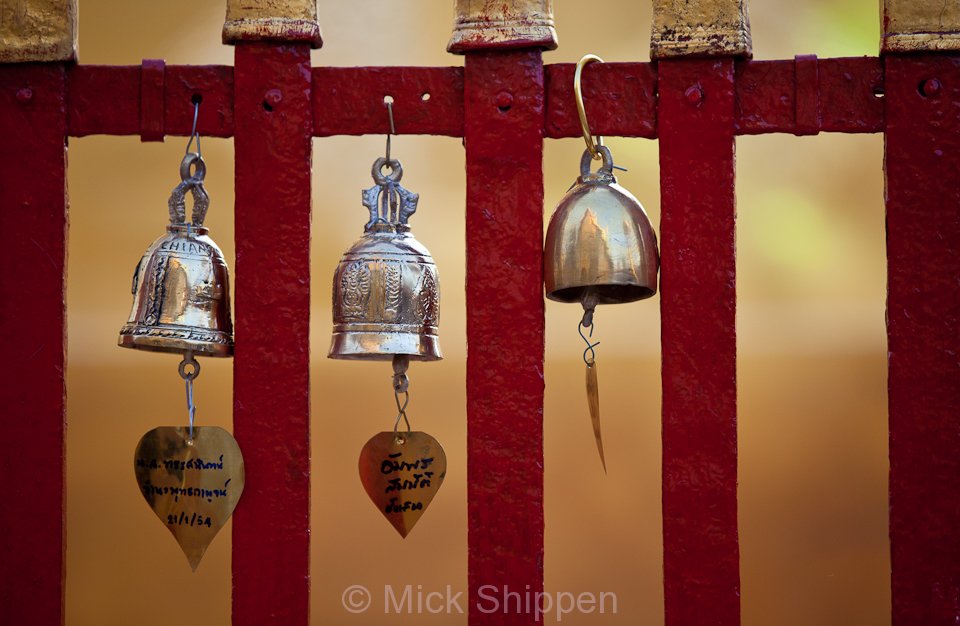
Getting there:
Chiang Mai lies 800 kilometres north of Bangkok and just over an hour away by air. Thai Airways and Air Asia fly direct whereas Bangkok Airways fly via Sukhothai.
The overnight train from Bangkok’s Hua Lampong station to Chiang Mai makes for an interesting and considerably cheaper travel option. The air conditioned carriages are comfortable and the train also features a restaurant car. Of the two trains that travel the Chiang Mai route the Nakornping Express is recommended. Be sure to book in advance and ask for a bottom bunk. They are wider and more comfortable that the upper bunks.
Comment » | Travel
January 10th, 2011 — 8:18pm
I have just returned from a long weekend in the town of Ayutthaya, one of the most culturally and historically interesting towns within easy reach of Bangkok. Thailand’s former capital is a must on any travel itinerary.
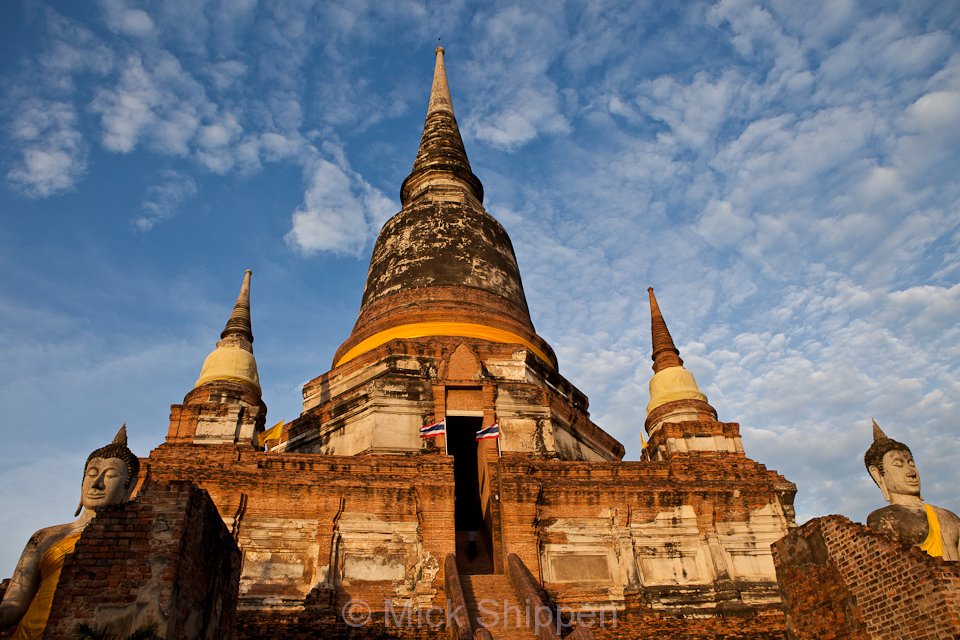
Once praised by foreign emissaries as the finest town they had ever seen (at least according to Tourist Authority of Thailand it was), today many of the ancient ruins have now been encroached upon by the new town resulting in a typically ramshackle Thai approach to preservation. Indeed the site was given UNESCO World Heritage status but I heard that this may be at risk due to the over commercialization of areas within the park with souvenir stalls and so on. The town certainly does get overrun with foreign and local tourists eager to buy the tat on offer but I see no reason way it can’t be kept away from the temple sites. But this is Thailand after all – the land that never let heritage get in the way of making money…
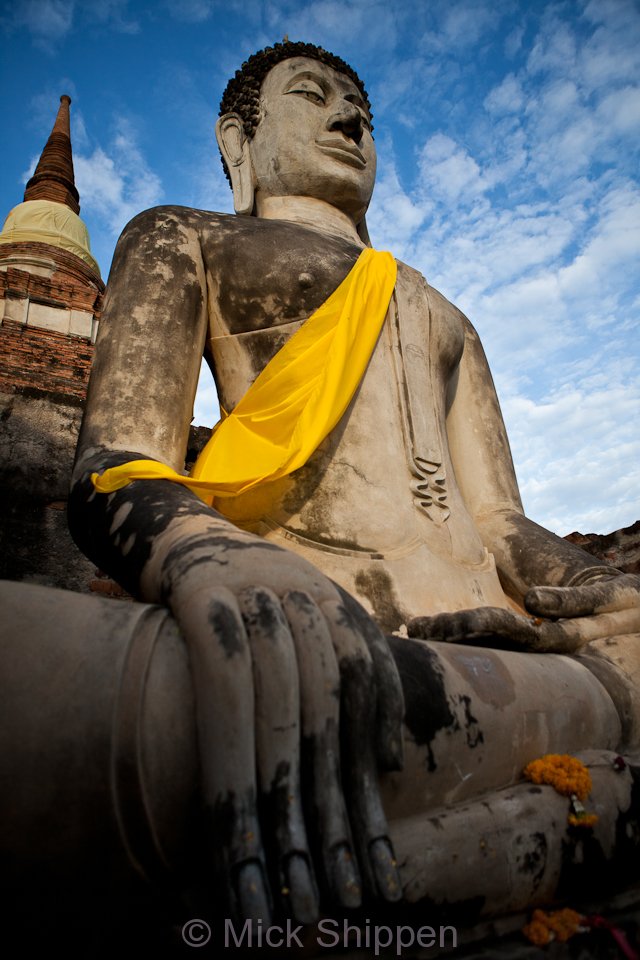
Ayutthaya was founded in 1350 by King U-Thong. During the 14th and 15th centuries the Thai kings of Ayutthaya had built the town with three palaces and over 400 temples. By the mid-16th century Ayutthaya was sacked by an invading Burmese army and, along with Lanna in north Thailand, came under their control.
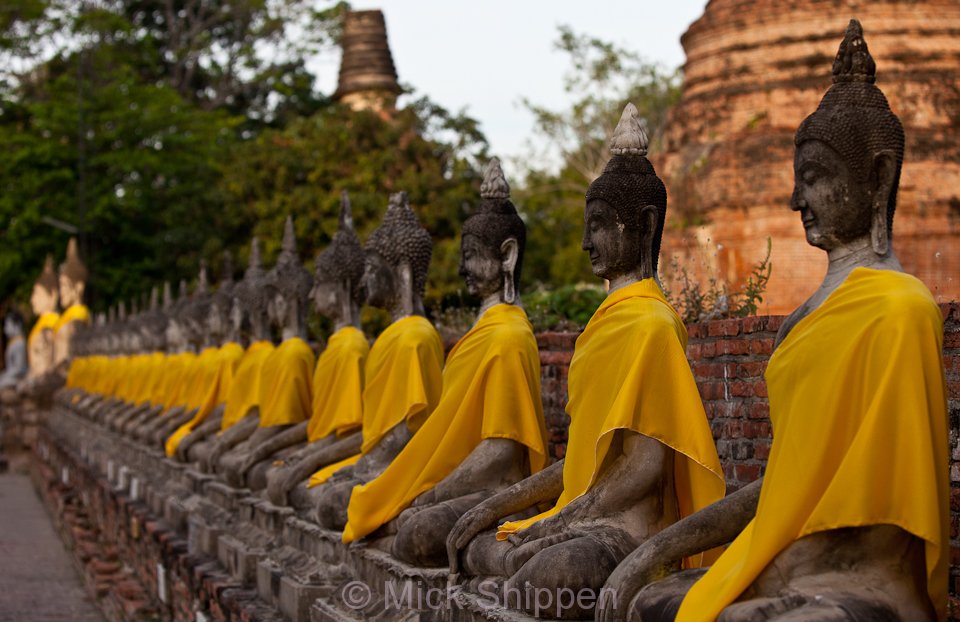
Although Thais regained control of both areas by the end of the century, the Burmese invaded Ayutthaya again in 1767, fighting and winning a fierce two-year battle. Many of the temples were destroyed.
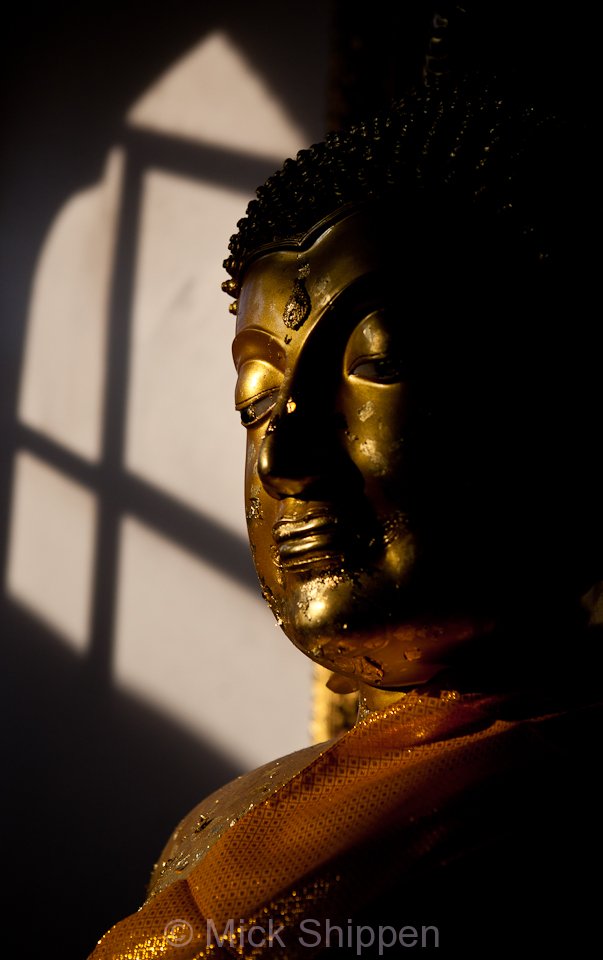
Situated approximately 86 kilometres from Bangkok, Ayutthaya can be reached by car in little over an hour, by train in 90 minutes (in theory at least. My trip on the way there took three hours), and by river.
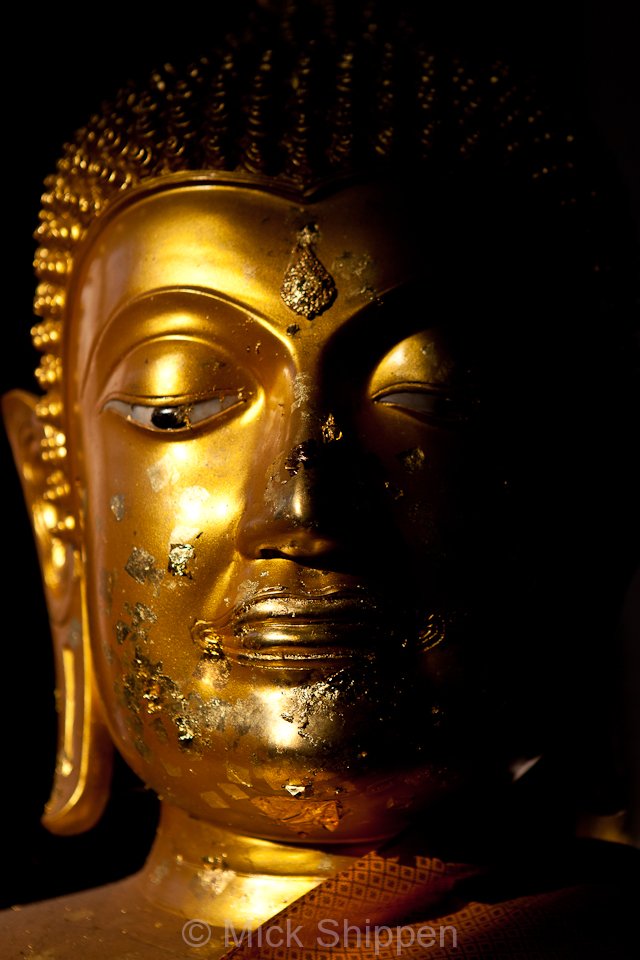
You can see a few more images from Ayutthaya in the Thailand gallery.
Comment » | Travel
January 6th, 2011 — 5:08pm
Of course, the downside of photographing Thailand’s main attractions is the inevitable temple and Buddha image overload. I’ve been traipsing round the major sites in Bangkok including one of my favourites, Wat Pho.
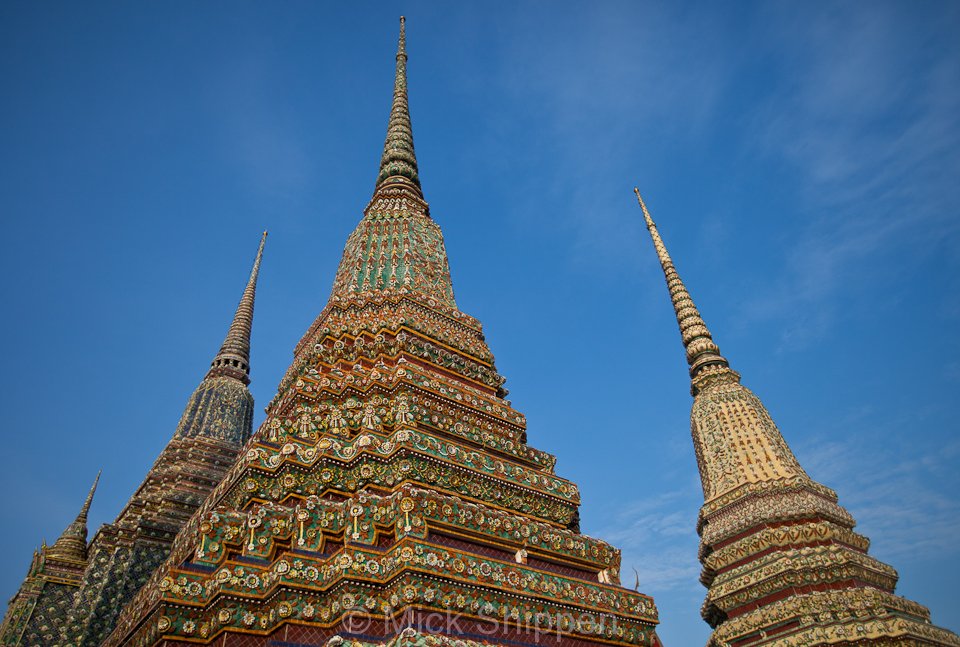
Also known as Wat Phra Chetuphon, Wat Pho is one of the finest temples in Bangkok and renowned for a huge reclining Buddha housed within a beautifully decorated hall. The 46 metre long and 15 metre high image was constructed in 1832 during the reign of King Rama III.
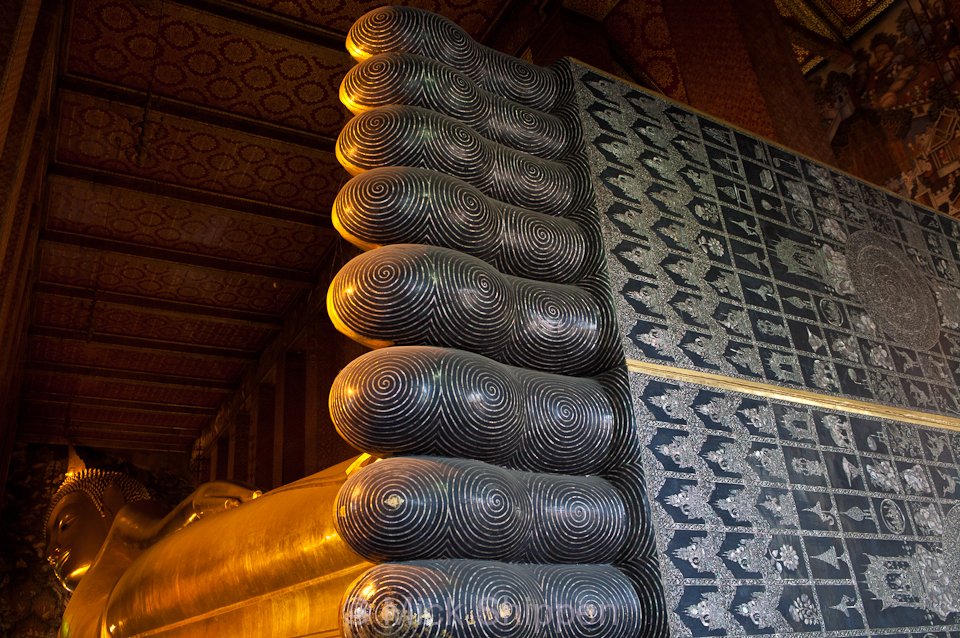
Designed to illustrate the passing of the Buddha into nirvana, the enormous feet feature mother-of-pearl inlay decoration showing the 108 auspicious characteristics of the true Buddha.
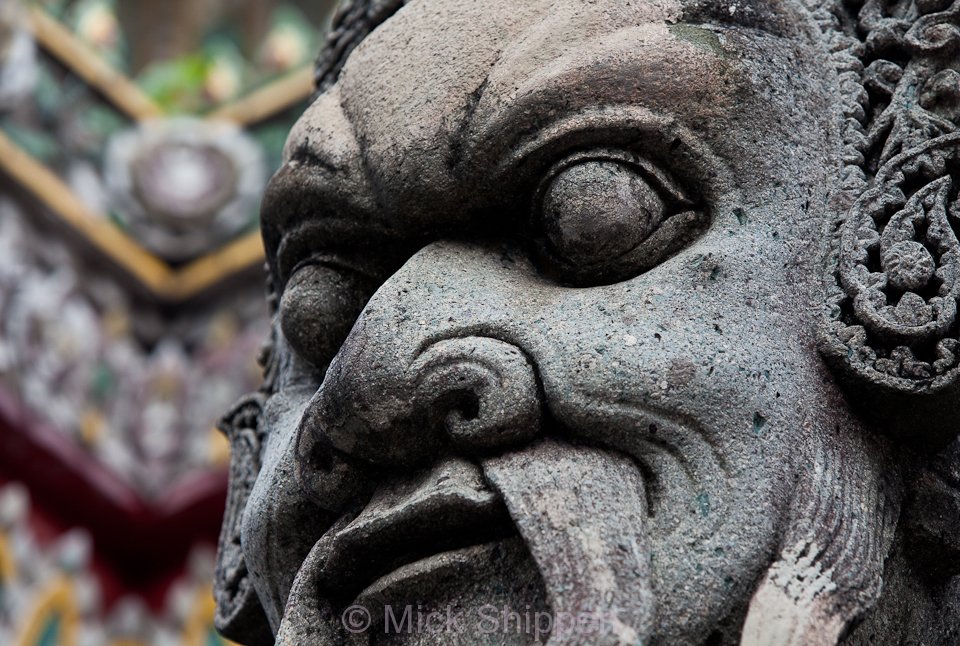
The inner and outer galleries are lined with 788 Buddha images, the largest collection in Thailand, and stone carvings of Chinese figures. Wat Pho is also a centre for the teaching traditional Thai medicine and massage. King Rama III instructed that the temple should become a centre of learning and had traditional knowledge inscribed on stone slabs.
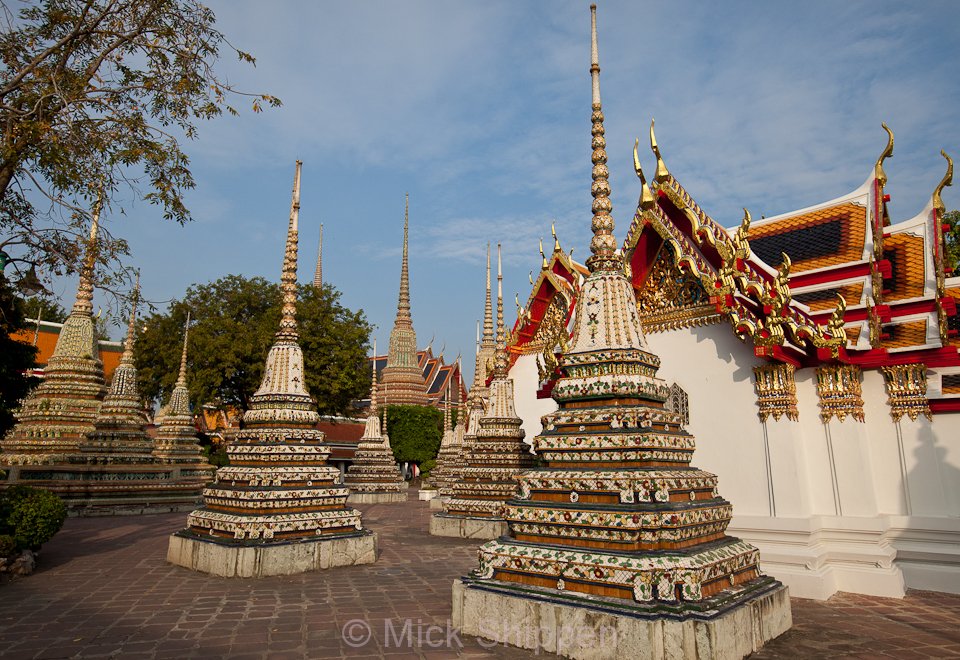
It is practically impossible to enjoy the temple without hordes of tourists but if you get there early you can grab a few quiet moments.
Comment » | Travel














































